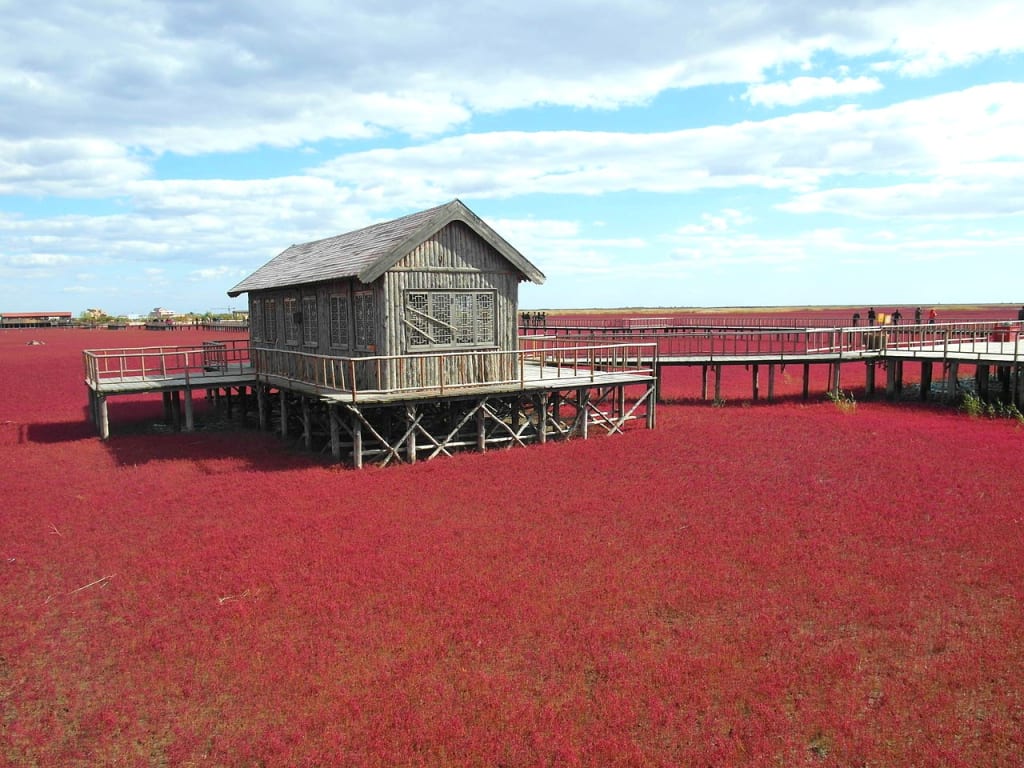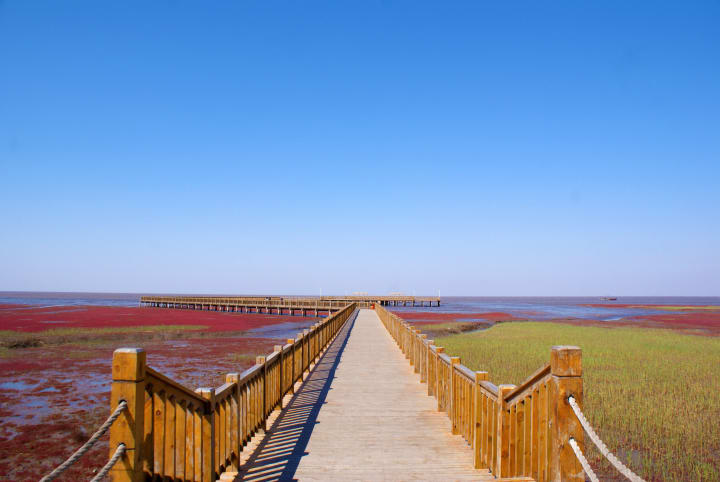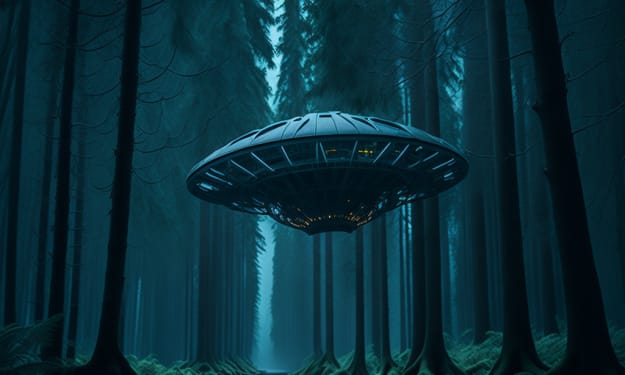The Mesmerizing Red Beach of Panjin: A Natural Masterpiece
Nature has a way of astounding us with its unparalleled beauty, and the Red Beach of Panjin stands as a testament to this captivating phenomenon.

Located in the northeastern region of China, the Red Beach is a mesmerizing blend of vibrant reds, soothing greens, and serene blues, creating an awe-inspiring spectacle that leaves visitors utterly enchanted. This unique coastal wetland, with its fascinating ecosystem and striking appearance, has captured the hearts and imaginations of all who have had the privilege to witness its beauty.
The Enigmatic Hue of Red
At first glance, the vivid red landscape of the Red Beach may seem like a painting come to life. However, this remarkable color is not the result of an artist's brushstrokes, but rather a natural occurrence that unfolds annually during the autumn months. The Suaeda salsa, a type of seepweed that calls the mudflats of Panjin home, takes on a vibrant crimson hue as it enters its growth cycle. The stunning transformation is the result of a complex chemical reaction involving the interaction of salt, alkaline soil, and temperature fluctuations. This botanical marvel is a living testament to the wonders of nature's chemistry.

Ecosystem Diversity
Beneath the sea of red lies a thriving ecosystem that supports a diverse array of flora and fauna. The Red Beach wetland is an essential stopover point for migratory birds along the East Asia-Australasia Flyway, providing a vital resting and feeding ground. Over 399 species of birds have been recorded in this area, including endangered and rare species such as the red-crowned crane and the Saunders's gull. The wetland also serves as a nursery for various fish species, contributing to the overall biodiversity of the region.
Beyond its visual appeal, the Red Beach of Panjin holds immense environmental importance. The Suaeda salsa plants play a crucial role in preventing coastal erosion, stabilizing the soil with their intricate root systems. This natural defense mechanism helps shield the coastline from the ravages of wind and waves, while also acting as a buffer against rising sea levels. The wetland's ability to sequester carbon dioxide from the atmosphere aids in mitigating the effects of climate change, making it an unsung hero in the fight against environmental degradation.
Conservation Efforts and Sustainable Tourism
Recognizing the need to preserve this ecological wonder, conservation efforts have been launched to protect the Red Beach and its fragile ecosystem. The establishment of the Panjin Red Beach National Nature Reserve in 1988 marked a significant milestone in safeguarding the area's biodiversity. The reserve's management employs measures to regulate tourism and ensure minimal disruption to the environment. Visitors are treated to a harmonious blend of natural beauty and sustainable travel practices, allowing them to appreciate the Red Beach's splendor without compromising its future.
A journey to the Red Beach of Panjin is an immersive experience that captivates the senses. The wooden boardwalks and observation platforms offer panoramic views of the landscape, allowing visitors to stroll amid the vibrant seepweed while minimizing ecological impact. The changing seasons bring about different shades of red and accompanying birdlife, creating a dynamic spectacle that transforms with each passing month. The harmony of colors, the soothing sound of rustling reeds, and the presence of diverse bird species make this destination a sanctuary for nature enthusiasts and photographers alike.
The Red Beach of Panjin stands as a remarkable example of the sheer wonder that the natural world can bestow upon us. Its awe-inspiring red expanse, coupled with its vital ecological significance, creates a destination that not only captivates the eyes but also nourishes the soul. As visitors tread lightly upon the wooden walkways, they become part of a delicate dance between human curiosity and the delicate balance of nature. In a world where urban landscapes often overshadow the natural wonders, the Red Beach is a vivid reminder that there are still hidden gems that await our exploration and admiration.

Here are 10 intriguing trivia facts about the Red Beach of Panjin:
- Natural Marvel: The Red Beach isn't actually a beach in the traditional sense. It's a vast wetland covered in a unique type of seepweed that turns a brilliant shade of red during its growing season.
- Color Evolution: The seepweed's color isn't fixed; it changes from green to vivid red as it progresses through different growth stages. The red hue is most vibrant in autumn, creating a breathtaking visual spectacle.
- Global Rarity: The specific seepweed responsible for the red hue is called Suaeda salsa. While it exists in other parts of the world, the vibrant red transformation is seen only in Panjin due to specific environmental conditions.
- Carbon Sink: The Suaeda salsa not only contributes to the area's stunning appearance but also plays a significant role in carbon sequestration. It helps absorb carbon dioxide from the atmosphere, contributing to the fight against climate change.
- Birdwatcher's Paradise: The Red Beach is a vital pit stop for migratory birds along the East Asia-Australasia Flyway. Birdwatchers can spot a remarkable variety of avian species, including some endangered ones, making it a haven for ornithology enthusiasts.
- Protected Area: The Panjin Red Beach National Nature Reserve was established in 1988 to safeguard the delicate ecosystem of the area. It encompasses over 51 square kilometers and includes not only the red wetland but also sand dunes, salt flats, and tidal flats.
- Year-Round Attraction: While the iconic red hue is most prominent in autumn, the Red Beach offers a unique experience throughout the year. Spring and summer bring lush greenery, and winter can offer serene white landscapes.
- Biodiversity Hotspot: The wetland supports more than just the red seepweed. It's home to numerous plant and animal species, and the biodiversity of the area contributes to its ecological importance.
- Film Location: The stunning scenery of the Red Beach has attracted the attention of filmmakers. It has been featured in various documentaries and films that showcase its unique beauty and ecological significance.
- Eco-Friendly Tourism: The management of the Red Beach has prioritized sustainable tourism. Wooden walkways and viewing platforms have been strategically placed to allow visitors to experience the beauty while minimizing disturbance to the fragile ecosystem.


About the Creator
Enjoyed the story? Support the Creator.
Subscribe for free to receive all their stories in your feed. You could also pledge your support or give them a one-off tip, letting them know you appreciate their work.






Comments
There are no comments for this story
Be the first to respond and start the conversation.